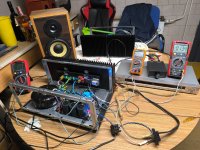Just finishing up an F6 Diamond.
Thanks to Nelson, TungstenAudio, 2PicoDumbs, MarkJohnson, 6L6.
Active bridges. Dual Mono. Thanks to all who posted pics of their dual mono setups for inspiration in a 4Ux300 chassis.

Thanks to Nelson, TungstenAudio, 2PicoDumbs, MarkJohnson, 6L6.
Active bridges. Dual Mono. Thanks to all who posted pics of their dual mono setups for inspiration in a 4Ux300 chassis.
bsk,
That's a very well organized and good looking building - kudos!
At the first glance I was a bit puzzled seeing 3 capacitors in each of the power supply PCBs, but on closer inspection noticed that it's a stacked build with a PCBs underneath the ones visible from the top. 🙂
What speakers are you going to use with these? Any listening impressions yet?
That's a very well organized and good looking building - kudos!
At the first glance I was a bit puzzled seeing 3 capacitors in each of the power supply PCBs, but on closer inspection noticed that it's a stacked build with a PCBs underneath the ones visible from the top. 🙂
What speakers are you going to use with these? Any listening impressions yet?
Ooh, I've got F6 jealousy going on now. Very nice.
I'm still confused about the "missing" cap. Dual mono has 2 rails for each channel, so the 4 boards makes sense. Is there a reason to leave out a cap in the CRC?
I'm still confused about the "missing" cap. Dual mono has 2 rails for each channel, so the 4 boards makes sense. Is there a reason to leave out a cap in the CRC?
Thanks, I'll have to scratch my head on how that works. Makes no sense to me with my current understanding, but I'm a dodohead, so things come to me very slowly, if ever at all. Ill do some circuit diagram investigations.
I see resistors on both the bottom and top PCBs - so possibly running as C-R-C-R-C?
(2 x 27,000uF) - R - (2 x 27,000uF) - R - (2 x 27,000uF)
(2 x 27,000uF) - R - (2 x 27,000uF) - R - (2 x 27,000uF)
Ok, I think I was overthinking it. You simply left off a cap for each rail as you felt the large capactance of the caps was already plenty. You could have put that ground connector in any of the ground through holes to connect the boards if you wanted to use 4 caps per rail. You used that particular location because it had bigger thru holes. I thought there was some sort of audio trickery to share the caps so each rail was somehow sharing capacitance with the other. This is pretty standard use of the store PSU boards as dual rail stacked config, with leaving out a cap and going with 3 caps per rail as the only real "tweak". That, or I still have no clue what I'm talking about...which is still highly likely.
Last edited:
@zman01
Speakers - OSMCs in one room and a pair of Jordan Eikonas in Jim Griffin designed quarter wave cabinets in another room.
The amp was just powered up yesterday - so in need of some time. Tonality is already quite nice. Cymbals are reproduced well.
More to come.
Speakers - OSMCs in one room and a pair of Jordan Eikonas in Jim Griffin designed quarter wave cabinets in another room.
The amp was just powered up yesterday - so in need of some time. Tonality is already quite nice. Cymbals are reproduced well.
More to come.
Just out of curiosity, is there a noticeable benefit for using these large amounts of capacitance in the power supplies and if so, does this change with different manufacturers?
@zman01
Speakers - OSMCs in one room and a pair of Jordan Eikonas in Jim Griffin designed quarter wave cabinets in another room.
The amp was just powered up yesterday - so in need of some time. Tonality is already quite nice. Cymbals are reproduced well.
More to come.
You have nice speakers bsk; especially the OSMC.
@jameshillj
There is a point of diminishing returns; and this is probably past it. In-rush current can be a lot - I am using the SL15_60002 current limiters (Thanks Mark for the nice write-up on these) on the primary sides of the power transformers. They are dropping 3VAC when fully hot (~80C here).
I bought a lot of these caps several years ago. They are Nichicon LKS which have been discontinued. All of my FirstWatt clones are using these.
There is a point of diminishing returns; and this is probably past it. In-rush current can be a lot - I am using the SL15_60002 current limiters (Thanks Mark for the nice write-up on these) on the primary sides of the power transformers. They are dropping 3VAC when fully hot (~80C here).
I bought a lot of these caps several years ago. They are Nichicon LKS which have been discontinued. All of my FirstWatt clones are using these.
@jameshillj
Should have answered the question more directly: More energy storage, less ripple voltage, but heavier ripple current. Lots of opinions on cap manufacturers and how they affect the sound.
Should have answered the question more directly: More energy storage, less ripple voltage, but heavier ripple current. Lots of opinions on cap manufacturers and how they affect the sound.
Now is probably a good time to get back to the IXTQ75N10P Mosfets that I was experimenting with earlier. These look promising as substitutes for the FQH44N10. They need a slightly higher threshold voltage to operate at the preferred bias current. The new PCBs make it easy to use a blue LED in each string to get a higher voltage for setting the bias.
- Home
- Amplifiers
- Pass Labs
- The F6 Revisited
